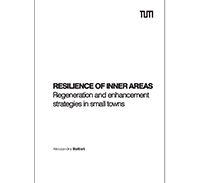Resilience of inner areas. Regeneration and enhancement strategies in small towns.

In the current global economic system, Europe’s minor historic towns – the pulsing heart of the very meaning of Europe – are gradually losing their attractiveness due to the trend of the population’s growing concentration in large cities. In fact, small- and medium-sized towns located in peripheral areas appear incapable today of undertaking a prospect for development. The problem has gradually exacerbated the gap between large cities and small towns, although the latter offer greater liveability and quality of life.
This book focuses attention on inner and marginal territories dotted with villages and minor towns. Less accessible, they are marked by scant services and inadequate job opportunities. For this reason, they suffer from a gradual depopulation that has at times resulted in their abandonment, also impoverishing the maintenance of their buildings, urban planning, and landscape.
For inner areas, the need to provide a response to the challenges raised by climate change, pandemics, and the current economic and structural situation appears to offer new opportunities for development. These opportunities can make them socially and economically competitive, confirming their vocation by innovating it and cross-breeding it with other sectors like tourism, culture, and technology, while valorizing the benefits of the small size, human capital, and innate capacity for hospitality present within the communities settled there.
In this perspective, this book attempts to depict inner areas’ capacity for resilience, provided by the innovative thrust furnished by three essential topics: hospitality, creativity, and the spread of ICT.
Author: Alessandra Battisti
Introduction: Thomas Auer
ISBN: 978-3-948278-20-5
Open Access PDF: here